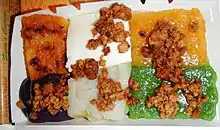Maja blanca
Maja blanca (literally "white maja" in Spanish; Tagalog: [ˈmaha ˈblaŋka]) is a Filipino dessert made primarily from coconut milk. Also known as coconut pudding, it is usually served during fiestas and during the holidays, especially Christmas.
  | |
| Alternative names | Coconut pudding, Coconut cake, dudul |
|---|---|
| Course | Dessert |
| Place of origin | Philippines |
| Serving temperature | Room temperature, cold |
| Main ingredients | Coconut milk, cornstarch |
| Variations | Maja blanca con maiz. Maja de ube |
| Similar dishes | Tibok-tibok |
Description
Maja blanca has the consistency of thick gelatine and a delicate flavor, and is creamy white in color.
Etymology and history
The dessert is the local Filipino adaptation of the Spanish dish manjar blanco (blancmange), but it has become distinct in that it uses very different ingredients, like coconut milk instead of milk or almond milk. The dish was most popular in Luzon, especially in Tagalog, Kapampangan, Pangasinense, and Ilocano cuisine. But it was also popular in the south, especially among Chavacano-speaking Zamboangueños.[1][2]
Maja blanca takes its name from the flamboyant majas of 18th- and 19th-century Spanish society. Maja blanca is also known as dudul in Ilocano;[1] as well as maja blanca con maíz, maja maíz, or maja blanca maíz when corn kernels are used in the preparation (maíz is Spanish for corn).[3]
Preparation
Maja blanca is relatively easy to prepare. A coconut milk (not coconut cream) and cornstarch mixture is heated to boiling over a low flame while stirring. Agar (gulaman in Filipino) can be substituted for cornstarch.[2] Corn kernels, milk, and sugar are also often added, though these are not traditionally part of the recipe.[4] Once the mixture thickens, it is then poured into serving dishes previously greased with coconut oil and allowed to cool. Once firm, latik (browned coconut cream curds) are then sprinkled as toppings.[3]
It is also often refrigerated and served cold to improve the texture.[5]
Maja blanca is similar in texture to panna cotta, but the flavor is different due to the coconut milk.
The corn kernels and latik are used to add different textures to the maja blanca, which, by itself, usually has a creamy texture.[6]
Variations
Maja blanca can easily be adapted to include various other ingredients, often resulting in changes in the color of the dish. Examples include squash maja blanca which uses calabazas (Filipino: kalabasa)[7] and a version of maja maiz that uses butter, resulting in a distinctive yellow color.[8]
Other common variants include maja de ube (or maja ube), a deep purple variant of maja blanca which uses ube (purple yam);[9] and maja buko pandan a light green variant which is flavored with pandan leaves and coconut meat.[10]
See also
References
- Edgie Polistico (2017). Philippine Food, Cooking, & Dining Dictionary. Anvil Publishing, Incorporated. ISBN 9786214200870.
- "Maja Blanca". Driftless Appetite: Life & Food in the Driftless Area. Retrieved November 26, 2011.
- Reynaldo G. Alejandro & Doreen G. Fernandez (1998). Food of the Philippines. Tuttle Publishing. p. 102. ISBN 978-962-593-245-3.
- Vanjo Merano (November 8, 2009). "Maja Blanca". Panlasang Pinoy. Retrieved July 4, 2011.
- J. Dagoon (2005). Home Economics Technology IV. Rex Bookstore, Inc. p. 89. ISBN 978-971-23-4221-9.
- "Maja Blanca Recipe Filipino by Pilipinas Recipes".
- Regional Field Unit No. 5. Emily B. Bordado (ed.). Vegetable-based recipes (PDF). Department of Agriculture, Republic of the Philippines. p. 11.
- "Maja Maiz". Home Cooking Rocks!. July 30, 2004. Archived from the original on May 2, 2011. Retrieved July 4, 2011.
- Dagoon; et al. (1999). Culinary Arts I. Rex Bookstore, Inc. p. 269. ISBN 978-971-23-2603-5.
- "Buco Pandan Maja with Corn". Mely's Kitchen. Retrieved 28 April 2018.

